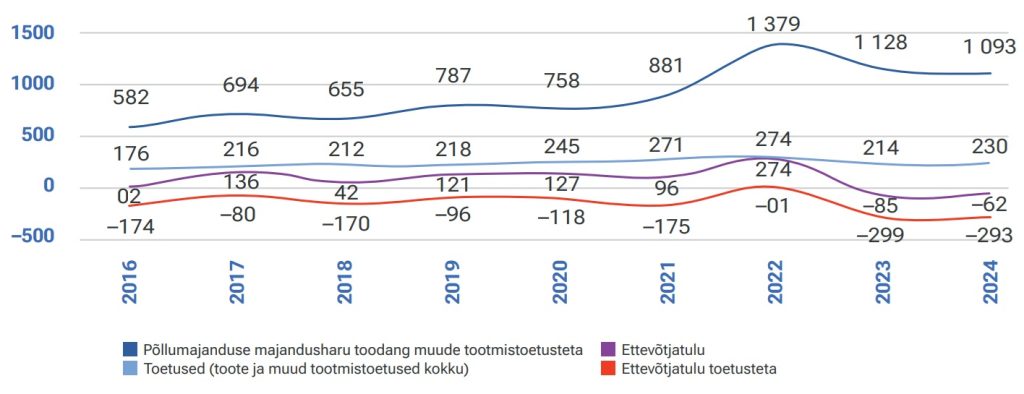Report: Estonian farmers are producing more but earning less
According to the Foresight Centre’s new short report, Estonian agricultural producers are operating at a loss, despite investments and growth in productivity. Rising costs and a low level of value added to raw materials reduce competitiveness.

Uku Varblane, head of research at the Foresight Centre, said that although subsidies have helped agricultural producers invest and increase production volumes, the sector has not made a profit in recent years. “Farmers provide the population with high-quality and valuable food and ensure Estonia’s food security, while having to produce internationally competitive products and add as much value as possible to their produce,” said Varblane.
Although Estonia’s strengths are cereal farming and dairy production, lower-value products, such as raw milk, tend to be exported in these sectors. Since 2018, the share of value-added products in exports has decreased, from 55% to 48%. The share of value-added products in exports is highest among dairy products, accounting for around 60%; however, it is still lower than imported dairy products, where the share of value-added products is nearly 70%.
“Today, the Estonian dairy sector is actively seeking opportunities for developing and adding value to products, but as Estonian companies are small, competing with large foreign groups is difficult for us,” said Varblane.
In its short report ‘Trends and Competitiveness in Estonian Agriculture’, the Foresight Centre points out that Estonian agricultural producers have been operating at a loss for the past two years. This is because the prices of goods and services used as inputs in the production process have increased faster than sales revenue and the level of value added to agricultural products is low. In the last five years, the prices have increased rapidly for energy and motor vehicle fuels (82%), animal feed (38%), fertilisers (35%) and seeds (31%). Also, Estonian agriculture uses more foreign-origin production inputs than our neighbouring countries do.
Use of by-products and product development, including in organic production, are considered to be future trends in agricultural production. Experts have found that Estonia has good potential for developing mixed production, for example by combining cereals, milk and biogas production and a circular bioeconomy.
The Foresight Centre stresses in its short report that in the last decade, the level of value added to agricultural raw materials has not changed significantly in Estonia. The share of value-added processing in cereal products with the largest production volume has actually decreased, while in meat and dairy products it has remained stable. In recent years, the share of value-added products has grown the most among fruit and vegetable products, having increased by a fifth in monetary value.
The expansion of organic farming has good prospects, as Estonia has favourable climatic conditions for this. However, the Foresight Centre finds that it is also important to look for ways to process organic production into products with higher added value.
The short report ‘Trends and Competitiveness in Estonian Agriculture’ (in Estonian) has been prepared within the framework of the research stream ‘The Future of Economic Competitiveness’. The research stream analyses the future prospects, opportunities and obstacles of the Estonian economy and presents promising economic policy recommendations. The research stream is part of the work of the competitiveness expert group established at the Economic Affairs Committee of the Riigikogu.
Latest news
-
10.11 2025Report: Estonia could learn how to control healthcare costs from the Netherlands
The expenses of the Estonian Health Insurance Fund significantly exceed its revenues, and the accumulated reserves will be depleted in the next five years. Other European countries in the same situation have cut healthcare services and increased people’s co-payments. According to the Foresight Centre’s new short report “Other countries’ experiences in managing healthcare budget deficits”, both solutions have worsened public health and deepened inequality.

 An independent think tank at the Riigikogu
An independent think tank at the Riigikogu